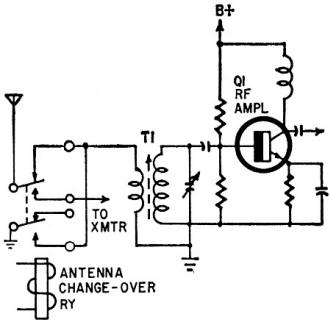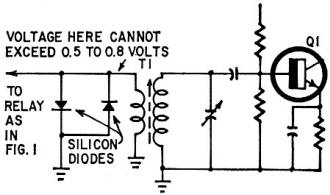RF Circuit Protection
|
|
When transistors finally began operating in the hundreds of MHz in the 1960s, power handling was still relatively low, and the devices could be damaged or destroyed by a large signal, particularly, as cited in this "RF Circuit Protection" article from a 1969 issue of Radio-Electronics magazine, when the relay switching the antenna between transmit and receive does not have adequate isolation. Another scenario is operating in a close-quarters group of radio operators at a Hamfest, emergency communications post, etc. Over time, more robust transistors were designed, and some had built-in protection diodes. As gate sizes shrank, vulnerability to electrostatic discharge (ESD) reared its ugly head in RF integrated circuits like frontend modules and switches. During the early 2000s, IC makers like RF Micro Devices (now Qorvo), Skyworks (spun off from Alpha Industries), Renesas, and a few others, were in a race to conform to the de facto ESD standards for human body model (HBM) and machine model (MM, not used any more) survivability. The challenge was not so much being able to protect the I/O pins, but the amount of wafer real estate required to accommodate the protection diodes and/or transistors. RF Circuit ProtectionBy Irwin Math In many transistorized converters and high-frequency front ends, especially those designed for mobile two-way radio and amateur applications, a potential condition exists which could easily destroy the input transistor. Figure 1 is a schematic of such a front end. When the transmitter is turned on the antenna changeover relay is supposed to short the receiver input to ground. Even if the relay does make excellent contact, a small signal is usually induced in the primary of the receiver's rf transformer, (T1) especially if the operating frequency is in the uhf region. If, on the other hand, the relay makes poor contact, a substantially large signal can appear at this coil. Since T1 is a step−up transformer (usually 50Ω to 200Ω or so) approximately twice the primary voltage appears in the secondary between the base and emitter of Q1. Assuming the transmitter puts out only 10 watts into a 50Ω antenna, we have about 60 volts peak-to-peak at the antenna. Unless that shorting contact is pretty good, we can say goodbye to Q1, which can only take a maximum of 3-4 volts between base and emitter. Let's say that everything is working properly however. This condition still exists. When S1 switches from transmit to receive, there is an instant when the receiver line is not shorted and the transmitter is still delivering power. This is due to the fact that the electrolytics in the transmitter take some time to discharge, therefore even if the transmitter supplies power for only 50 milliseconds (0.05 sec) after the relay opens, Q1 will still be destroyed by the high-voltage pulse produced. A simple method for protecting against accidental overloads of this nature is given in Fig. 2. Two silicon switching diodes are connected in parallel opposing across the input coil. These diodes exhibit extremely high forward resistances when the voltage applied to them is below 0.5 to 0.8 volt. Any higher voltage causes the diodes to conduct and the forward resistance drops to a couple of ohms. In this manner, the input voltage to the rf amplifier is always kept to a safe level. Any medium- to fast-speed silicon switching diodes can be used in this circuit. Germanium diodes do not have the same low-voltage characteristics and will not work.
Posted August 21, 2023 |
|


